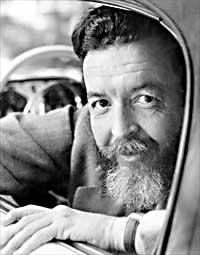Randall Jarrell facts for kids
Quick facts for kids
Randall Jarrell
|
|
|---|---|
 |
|
| Born | May 6, 1914 Nashville, Tennessee |
| Died | October 14, 1965 (aged 51) Chapel Hill, North Carolina |
| Occupation | Poet, critic, and novelist |
| Notable works | The Woman at the Washington Zoo, The Lost World, Pictures from an Institution |
| Notable awards | National Book Award |
Randall Jarrell JƏ-rel (May 6, 1914 – October 14, 1965) was an American poet, literary critic, children's author, essayist, and novelist. He was the 11th Consultant in Poetry to the Library of Congress—a position that now bears the title Poet Laureate of the United States.
Among other honors, Jarrell was awarded a Guggenheim Fellowship for the years 1947–48; a grant from the National Institute of Arts and Letters, in 1951; and the National Book Award for Poetry, in 1961.
Biography
Youth and education
Jarrell was a native of Nashville, Tennessee. He attended Hume-Fogg High School where he "practiced tennis, starred in some school plays, and began his career as a critic with satirical essays in a school magazine." He received his B.A. from Vanderbilt University in 1935. While at Vanderbilt, he edited the student humor magazine The Masquerader, was captain of the tennis team, made Phi Beta Kappa and graduated magna cum laude. He studied there under Robert Penn Warren, who first published Jarrell's criticism; Allen Tate, who first published Jarrell's poetry; and John Crowe Ransom, who gave Jarrell his first teaching job as a Freshman Composition instructor at Kenyon College in Gambier, Ohio. Although all of these Vanderbilt teachers were heavily involved with the conservative Southern Agrarian movement, Jarrell did not become an Agrarian himself. According to Stephanie Burt, "Jarrell—a devotee of Marx and Auden— embraced his teachers' literary stances while rejecting their politics." He also completed his master's degree in English at Vanderbilt in 1937, beginning his thesis on A. E. Housman (which he completed in 1939).
When Ransom left Vanderbilt for Kenyon College in Ohio that same year, a number of his loyal students, including Jarrell, followed him to Kenyon. Jarrell taught English at Kenyon for two years, coached tennis, and served as the resident faculty member in an undergraduate dormitory that housed future writers Robie Macauley, Peter Taylor, and poet Robert Lowell. Lowell and Jarrell remained good friends and peers until Jarrell's death. According to Lowell biographer Paul Mariani, "Jarrell was the first person of [Lowell's] own generation [whom he] genuinely held in awe" due to Jarrell's brilliance and confidence even at the age of 23.
Career
Jarrell went on to teach at the University of Texas at Austin from 1939 to 1942, where he began to publish criticism and where he met his first wife, Mackie Langham. In 1942 he left the university to join the United States Army Air Forces. According to his obituary, he "[started] as a flying cadet, [then] he later became a celestial navigation tower operator, a job title he considered the most poetic in the Air Force." His early poetry, in particular The Death of the Ball Turret Gunner, would principally concern his wartime experiences in the Air Force.
The Jarrell obituary goes on to state that "after being discharged from the service he joined the faculty of Sarah Lawrence College in Bronxville, N.Y., for a year. During his time in New York, he also served as the temporary book review editor for The Nation magazine." However, Jarrell was uncomfortable living in the city and "claimed to hate New York's crowds, high cost of living, status-conscious sociability, and lack of greenery.". He soon left the city for the Woman's College of the University of North Carolina where, as an associate professor of English, he taught modern poetry and "imaginative writing."
Jarrell divorced his first wife and married Mary von Schrader, a young woman whom he met at a summer writer's conference in Colorado, in 1952. They first lived together while Jarrell was teaching for a term at the University of Illinois at Champaign-Urbana. Then the couple settled back in Greensboro with Mary's daughters from her previous marriage. The couple also moved temporarily to Washington D.C. in 1956 when Jarrell served as the consultant in poetry at the Library of Congress (a position that later became titled "Poet Laureate") for two years, returning to Greensboro and the University of North Carolina after his term ended.
Death
Randall died on October 14, 1965, while walking along U.S. highway 15-501 near Chapel Hill, N.C., where he was struck by a car and killed.
Legacy
On February 28, 1966, a memorial service was held in Jarrell's honor at Yale University, and some of the best-known poets in the country attended and spoke at the event, including Robert Lowell, Richard Wilbur, John Berryman, Stanley Kunitz, and Robert Penn Warren. Reporting on the memorial service, The New York Times quoted Lowell who said that Jarrell was "'the most heartbreaking poet of our time'. . . [and] had written 'the best poetry in English about the Second World War.'" These memorial tributes formed the basis for the book Randall Jarrell 1914-1965 which Farrar, Straus and Giroux published the following year.
In 2004, the Metropolitan Nashville Historical Commission approved placement of a historical marker in his honor, to be placed at his alma mater, Hume-Fogg High School. A North Carolina Highway Historical Marker was placed near his burial site in Greensboro, North Carolina.
Children's books
He wrote several children's books, among which The Bat-Poet (1964) and The Animal Family (1965) are considered prominent (and feature illustrations by Maurice Sendak). Jarrell translated poems by Rainer Maria Rilke and others, a play by Anton Chekhov, and several Grimm fairy tales.
See also
 In Spanish: Randall Jarrell para niños
In Spanish: Randall Jarrell para niños

